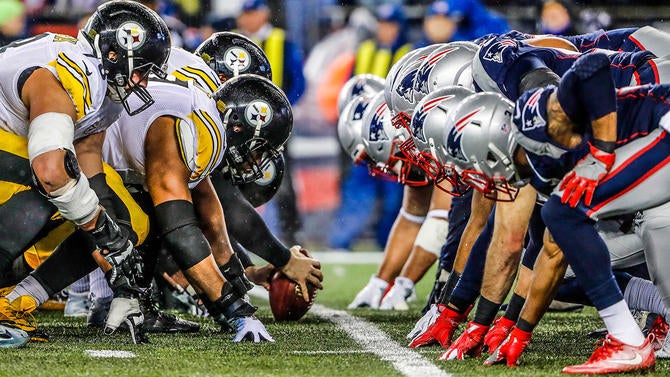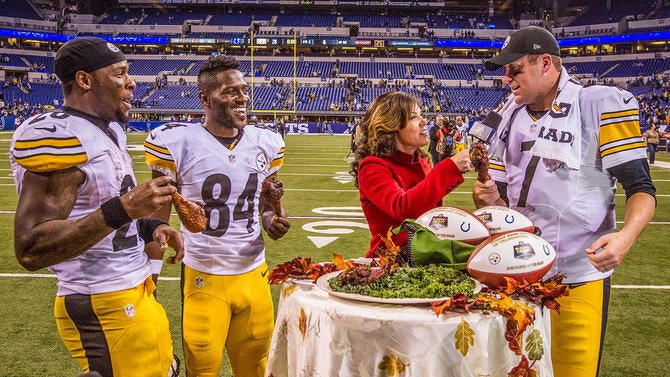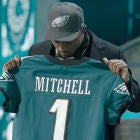Here’s how the Steelers’ past three seasons have ended: Wild-card loss to the Ravens, divisional-round loss to the Broncos, conference championship loss to the Patriots. Both Denver and New England went on to win the Super Bowl. If we assume that the Steelers’ success is linear, then in a year’s time they will be in their ninth Super Bowl.
Unfortunately for Steelers fans, a straight line isn’t representative of the relational complexities of more than five months of football. In simpler terms: In the NFL, past success doesn’t guarantee you anything in the future.
Look no further than the Carolina Panthers, who went 15-1 in 2015 and faced the aforementioned Broncos in Super Bowl 50. With many of the same players -- including MVP Cam Newton -- the Panthers went from outscoring opponents by 192 points in ‘15 to being outscored by 33 points a season later, when they limped to a 6-10 record and finished last in the NFC South. The primary culprit: Newton struggled, which was due in part to the lack of consistency along the offensive line.
But unlike the Panthers, the Steelers aren’t so reliant on one player. Yes, any conversation of Lombardi Trophies is immediately rendered meaningless if the team in question is without a franchise quarterback, but Pittsburgh also has the league’s best running back, one of its two or three best wide receivers and one of the most underrated offensive lines. There’s also that defense, which ranked 30th in 2014 -- Dick LeBeau’s last season as defensive coordinator -- and not only got younger in the two years since, but finished 11th in both 2015 and ‘16.
This consistency across the roster has been a staple of the Ben Roethlisberger era. Since 2004, when Roethlisberger was drafted, the Steelers are 150-78, according to teamrrankings.com, second only to -- you guessed it -- the Patriots, who have gone 181-55 over that same period.

It’s hardly bold to proclaim that the Steelers will head into the 2017 season as not just favorites in the division, but also the AFC. There is the matter of getting past New England, which has dominated Pittsburgh -- most recently in January’s AFC Championship Game. But if the Steelers can finally clear that hurdle, it will be their best chance for that seventh Lombardi Trophy.
Here’s how it all happens ...
It all starts with the Patriots
The NFL schedule won’t come out until later this spring but the Steelers already know that, in addition to their six AFC North games, they’ll host the Patriots. They faced the Patriots in Heinz Field in October, but that was without Roethlisberger. Backup Landry Jones was serviceable but the Pats prevailed 27-16.
The last time the Patriots came to Pittsburgh with Big Ben under center -- October 2011 -- was also the last time the Steelers beat them. In that game, one that has been referenced countless times in the wake of January’s AFC title disaster, the Steelers eschewed the zone defense they are known for and relied heavily on a man-to-man scheme that disrupted Tom Brady’s ability to get the ball out quickly. The ability to get after Brady -- he was pressured for much of the game and was sacked three times -- also was critical to Pittsburgh’s success.

If this sounds familiar, it should. The Falcons had a similar game plan against Brady in the Super Bowl and it worked to perfection until about midway through the third quarter, when Atlanta’s defense started showing signs of fatigue and Brady capitalized. When it was over, the Falcons defense would be on the field for 99 snaps, which works out to about a game and a half. They were gassed, and worse, there wasn’t much they could do about it.
But the theory was sound. The key to slowing Brady is jamming his receivers at the line of scrimmage and making it difficult for them to get into their routes. Simply put: If timing is integral to the Patriots’ offense running smoothly, disrupting that timing is key. Also key: not leaving your defense on the field for 75 percent of the game.
Interestingly, the Steelers are 0-4 against the Patriots since that win in 2011. The differences from then to now include playing in Gillette Stadium (0-3), playing without Big Ben (0-1) and featuring zone-heavy defensive game plans (0-4). So while this might be putting the cart well ahead of the horse -- it’s February, after all -- the coaching staff might want to spend some time on how to utilize a man-to-man scheme in anticipation of Brady coming to town.
An astute reader might point out that even if Pittsburgh finds a way to beat the Patriots during the regular season, all bets are off once January rolls around, mostly because those games invariably take place in Foxborough. This brings us to our next point ...
Home field is a must
Again, it’s silly to try to forecast 10 months into the future, but here’s our thinking on this particular matter: The Patriots are nearly impossible to beat at home in the playoffs. Knowing this, it makes sense to play them away from Gillette Stadium.
Simple to write, much more difficult to execute.
Part of the problem: The Patriots have the luxury of playing in the AFC East, which all but guarantees them no less than five wins a year. The Steelers are annually battling the Ravens and Bengals, and that means the only victories written in stone come courtesy of the Browns. The other part of the problem: At points every season, the Steelers chronically underachieve. Of course, you could make a similar case for just about every other team, but Pittsburgh seems to have a knack for losing eminently winnable games. In 2016, there was the early-season loss to the 1-4 Dolphins, and the post-bye loss to the 3-4 Ravens. Pittsburgh lost to the 4-10 Ravens in Week 17 of the 2015 season, and had three more inexplicable defeats the season before that:
- 2014, Week 4: 2-1 Steelers lose to 0-3 Buccaneers, 27-24
- 2014, Week 10: 6-3 Steelers lose to 1-8 Jets, 20-13
- 2014, Week 13: 7-4 Steelers lose to 4-7 Saints, 35-32
Fun fact: According to Football Outsiders’ consistency metric, the Steelers have gone from the league’s 12th-most consistent team in 2014 to 18th in 2015 to the most inconsistent team last season. So how do the Steelers go about addressing this?
This offense will be stacked
On paper, anyway. And barring the unforeseen, that shouldn’t change in the coming months. The team is currently working to sign Antonio Brown to a long-term deal, and Le’Veon Bell will be next on the to-do list. They are two of the top offensive play-makers in the NFL. One of the issues last season for the Steelers’ passing game was that defenses were able to neutralize Brown because Roethlisberger had few options. Martavis Bryant was suspended for the year, Markus Wheaton landed on injured reserve, tight end Ladarius Green was hampered early by an ankle injury and later by a concussion and Sammie Coates played the final three months with various ailments, including several broken fingers.
Of those four players, Wheaton likely won’t return. Bryant, by all accounts, has spent his time away from football refocusing his energies. If he returns to the Steelers and is 80 percent of what he was in 2014 and ‘15, God help the rest of the AFC.
Martavis Bryant is making up for lost time FAST.
— NFL (@NFL) October 18, 2015
88-yard screen pass to the HOUSE!
Are you kidding me?!? #AZvsPIT http://t.co/6Z3f9eARLc
Bryant’s presence immediately alleviates the double-teams Brown faced for much of 2016 -- and if it doesn’t, fully expect Roethlisberger to go after whoever is charged with trying to cover Bryant. Of course, this assumes Bryant is reinstated by the league and he can stay out of trouble. Earlier this month, Steelers president Art Rooney was cautiously optimistic about Bryant’s future in Pittsburgh.
“Obviously, [Bryant] has a tremendous amount of talent and potential,” Rooney told reporters, via Joe Rutter of the Pittsburgh Tribune-Review. “To the extent that we can have him on the team and have him bring his talent to its fullest potential would be great, but we’ve got a ways to go before any of us understand where that is.”
Even without Bryant, the Steelers offense will be better; Coates will be healthy, something he couldn’t say after the first month of the 2016 season. But those first five games, before he was injured? My word. In each game, Coates had at least one reception of at least 41 yards, and his best effort came in Week 5 against the Jets, when he had a 72-yard touchdown and finished with six catches for 139 yards and two scores. That was also the same game he suffered two broken fingers. For an idea of how that affected his production, consider this: For the rest of the regular season, Coates had a whopping two receptions for 14 yards.

Then there’s Green, signed a year ago to replace the irreplaceable Heath Miller. Green missed the first two months of the season with an ankle injury and was introduced to the offense slowly. Just when he looked like the play-maker the Steelers were hoping for, he suffered a concussion in a Week 15 victory over the Bengals. He didn’t play again. But over that five-game span, he had a six-catch, 110-yard game against the Giants and a five-catch, 72-yard game against the Bengals. His ability to stretch the middle of the field eased Brown’s burden and complicated things for the defense.
To recap: The Steelers’ 2017 offense could feature Brown, Bryant, Coates and Green. And we haven’t even talked about slot receiver Eli Rogers, a favorite of offensive coordinator Todd Haley, and a player Roethlisberger appeared to trust more as the season progressed.
We also haven’t talked much about Bell, either. The Steelers could face the world’s best pass defense, but that same defense would be tasked with stopping this 20 times a game:
On 3rd & 9...
— NFL (@NFL) January 16, 2017
Just give it to @L_Bell26.
Then MOVE THE STICKS.
Wow. #HereWeGo #NFLPlayoffs https://t.co/CkzslJERkU
Then there’s the offensive line. For years a punchline, this group has quietly become the foundation to Big Ben & Co.’s success. In 2016, the line ranked second in run blocking and fourth in pass protection, according to Football Outsiders, a far cry from the indignities Roethlisberger suffered in 2011, the year before Haley arrived, when he took 40 sacks and the O-line was 20th in pass blocking. Last season, Roethlisberger was sacked 17 times.
On the other side of the ball ...
When Roethlisberger arrived in Pittsburgh, the defense was regularly a top-5 unit. That was the case when the Steelers won the Super Bowl in after the 2005 season (the unit ranked third) and ‘08 (they finished No. 1). But players got old, draft picks didn’t pan out and by 2012, the slide into mediocrity began. The defense ranked 13th that year, then fell to 19th and bottomed out at 30th in 2014. Then Keith Butler replaced LeBeau as defensive coordinator and a scheme change, along with an infusion of youth, saw the group get quicker, faster and more athletic.
Linebacker Lawrence Timmons was coach Mike Tomlin’s first draft pick in 2007, and he’s coming off a solid season, but he’s also a free agent and it’s unclear if the Steelers will pay to re-sign him. After Timmons, 27-year-old defensive end Cameron Heyward is the old man of the crew, a first-round pick in 2011. The Steelers’ best defensive player, Heyward missed the final 11 games of the 2015 season with a pectoral injury. He’ll play opposite Stephon Tuitt, a 24-year-old freak of nature who, like Heyward, is stout against the run and a terrorizing pass rusher. Between them on the defensive line: 2016 third-rounder Javon Hargrave, who needed little time to transition from South Carolina State to the NFL. He’s another athletic marvel who got better as the season progressed; the Steelers thought so much of the rookie that they were comfortable with him starting 13 games.
At linebacker, 2014 first-round pick Ryan Shazier is poised for a breakout season. He ran a sub-4.4 40-yard dash before the draft and his ability to sift through traffic and make plays behind the line of scrimmage is why the Steelers love him. He’s also a one-man contain on would-be runs to the outside, and his speed allows him to track any tight end in the league.
If the Steelers have a desperate need, it’s at pass rusher. Jarvis Jones, the 2013 first-round pick, never worked out, and he’ll almost certainly be elsewhere next season. But 2015 first-rounder Bud Dupree is progressing nicely, though he was slowed early last season by a groin injury. But when he finally got on the field for the final two months of the season, Dupree showed glimpses of his game-changing abilities, logging 4.5 sacks and a forced fumble. And in the wild-card round of the playoffs, he perpetrated this against Dolphins quarterback Matt Moore:
Matt Moore knocked out of game—briefly—by Bud Dupree hit https://t.co/Wvu8vUtH5V pic.twitter.com/CFs3NsuC6N
— Deadspin (@Deadspin) January 8, 2017
While Dupree’s progress is encouraging, James Harrison, who will turn 39 this spring, remains the Steelers’ most consistent pass rusher. This is a problem, at least in the sense that we don’t think Harrison can play forever. It’s why the Steelers will likely target another pass rusher in free agency, early in the draft or both.
In the defensive backfield, the youth movement continues; 2016 first- and second-round picks cornerback Artie Burns and safety Sean Davis were starters for the second half of their rookie seasons. And like Hargrave, they were much better in January than they were in October.
Pittsburgh’s defense finished just outside the top 10 the past two seasons, and as it continues to get younger, faster, more explosive, the expectation is that it will get better too. Expect the team to bolster the unit early in the 2017 draft. In fact, in the latest CBSSports.com mock drafts, Rob Rang has the Steelers taking Florida cornerback Teez Tabor, while Dane Brugler likes UCLA pass rusher Takkarist McKinley.
Put another way: Players who can get after the quarterback and play man-to-man defense -- which, incidentally, are at the top of the “This is how you beat the Patriots” to-do list -- are always welcome in Pittsburgh.






















